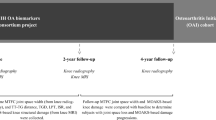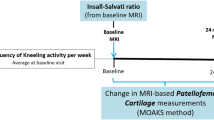Abstract
Objectives
To investigate the associations of medial and lateral patellofemoral osteoarthritis (PF-OA) at baseline with symptomatic and radiographic OA outcomes in the medial tibiofemoral compartment (MTFC) over 4 years, according to baseline overweight status.
Methods
Data and MRI images of 600 subjects in the FNIH-OA biomarkers consortium were used. Symptomatic worsening and radiographic progression of MTFC-OA were defined using Western Ontario and McMaster Universities Arthritis Index (WOMAC) pain scores and MTFC joint space narrowing (JSN) from baseline to 4-year follow-up. Baseline MRIs were read to establish PF-OA diagnosis. The association between baseline regional PF-OA pattern and odds for MTFC-OA progression was evaluated using regression models (adjusted for relevant confounding covariates including body mass index (BMI), age, sex, PF alignment measurements, KL grade, and knee alignment). To evaluate the effect modifying role for overweight status, stratification analysis was performed (BMI ≥ 25 vs. < 25 kg/m2).
Results
At baseline, 340 (56.7%), 255 (42.5%), and 199 (33.2%) subjects had OA in the medial, lateral, and both PF compartments. Baseline medial PF-OA was associated with WOMAC pain score and MTFC JSN progression at 4 years (Adjusted OR:1.56[95%CI:1.09–2.23] and 1.59[1.11–2.28], respectively) but not lateral PF-OA. In stratification analysis, overweight status was found to be an effect modifier for medial PF-OA and WOMAC pain (OR in overweight vs. non-overweight subjects:1.65[1.13–2.42] vs. 0.50[0.12–1.82]) as well as MTFC-JSN progression (1.63[1.12–2.4] vs. 0.75[0.19–2.81]).
Conclusions
In addition to the known confounding effect of BMI for PF-OA and MTFC-OA, the overweight status may also play an effect modifier role in the association between baseline medial PF-OA and MTFC-OA progression, which is amenable to secondary prevention.


Similar content being viewed by others
Abbreviations
- (BMI):
-
Body mass index
- (BML):
-
Bone marrow lesion
- (CI):
-
Confidence interval
- (DESS):
-
Dual-echo at steady state
- (FNIH):
-
Foundation for the National Institutes of Health
- (ISR):
-
Insall-Salvati ratio
- (IW):
-
Intermediate-weighted
- (JSN):
-
Joint space narrowing
- (JSW):
-
Joint space width
- (KLG):
-
Kellgren Lawrence grade
- (LPT):
-
Lateral patellar tilt
- (LTFC):
-
Lateral tibiofemoral compartments
- (MRI):
-
Magnetic resonance imaging
- (MTFC):
-
Medial tibiofemoral compartments
- (MOAKS):
-
MRI osteoarthritis knee scoring
- (MPRs):
-
Multiplane reconstructions
- (OR):
-
Odds ratio
- (OA):
-
Osteoarthritis
- (OAI):
-
Osteoarthritis Initiative
- (PF):
-
Patellofemoral
- (SD):
-
Standard deviation
- (TT-TG):
-
Tibial tuberosity to trochlear groove
- (TF):
-
Tibiofemoral
- (TGD):
-
Trochlear groove depth
- (TSE):
-
Turbo spino-echo
- (WE):
-
Water-excitation
- (WOMAC):
-
Western Ontario and McMaster universities osteoarthritis
References
Huétink K, Nelissen RG, Watt I, van Erkel AR, Bloem JL. Localized development of knee osteoarthritis can be predicted from MR imaging findings a decade earlier. Radiology. 2010;256(2):536–46.
Roemer FW, Zhang Y, Niu J, Lynch JA, Crema MD, Marra MD, et al. Tibiofemoral joint osteoarthritis: risk factors for MR-depicted fast cartilage loss over a 30-month period in the multicenter osteoarthritis study. Radiology. 2009;252(3):772–80.
Hochberg MC, Guermazi A, Guehring H, Aydemir A, Wax S, Fleuranceau-Morel P, et al. Effect of intra-articular Sprifermin vs placebo on Femorotibial joint cartilage thickness in patients with osteoarthritis: the FORWARD randomized clinical trial. Jama. 2019;322(14):1360–70.
Haj-Mirzaian A, Guermazi A, Pishgar F, Roemer FW, Sereni C, Hakky M, et al. Patellofemoral morphology measurements and their associations with tibiofemoral osteoarthritis-related structural damage: exploratory analysis on the osteoarthritis initiative. Eur Radiol. 2020;30(1):128–40.
Haj-Mirzaian A, Guermazi A, Pishgar F, Pourvaziri A, Roemer F, Sereni C, et al. Association of patella Alta with worsening of patellofemoral osteoarthritis-related structural damage: data from the osteoarthritis initiative. Osteoarthr Cartil. 2019;27(2):278–85.
Lankhorst NE, Damen J, Oei EH, Verhaar JAN, Kloppenburg M, Bierma-Zeinstra SMA, et al. Incidence, prevalence, natural course and prognosis of patellofemoral osteoarthritis: the cohort hip and cohort knee study. Osteoarthr Cartil. 2017;25(5):647–53.
Haj-Mirzaian A, Guermazi A, Hafezi-Nejad N, Sereni C, Hakky M, Hunter DJ, et al. Superolateral Hoffa’s fat pad (SHFP) oedema and patellar cartilage volume loss: quantitative analysis using longitudinal data from the Foundation for the National Institute of health (FNIH) osteoarthritis biomarkers consortium. Eur Radiol. 2018;28(10):4134–45.
Kobayashi S, Pappas E, Fransen M, Refshauge K, Simic M. The prevalence of patellofemoral osteoarthritis: a systematic review and meta-analysis. Osteoarthr Cartil. 2016;24(10):1697–707.
Duncan R, Peat G, Thomas E, Hay EM, Croft P. Incidence, progression and sequence of development of radiographic knee osteoarthritis in a symptomatic population. Ann Rheum Dis. 2011;70(11):1944–8.
McAlindon T, Zhang Y, Hannan M, Naimark A, Weissman B, Castelli W, et al. Are risk factors for patellofemoral and tibiofemoral knee osteoarthritis different? J Rheumatol. 1996;23(2):332–7.
Zhang W, McWilliams DF, Ingham SL, Doherty SA, Muthuri S, Muir KR, et al. Nottingham knee osteoarthritis risk prediction models. Ann Rheum Dis. 2011;70(9):1599–604.
Elahi S, Cahue S, Felson DT, Engelman L, Sharma L. The association between varus-valgus alignment and patellofemoral osteoarthritis. Arthritis Rheum. 2000;43(8):1874–80.
Roemer FW, Guermazi A, Collins JE, Losina E, Nevitt MC, Lynch JA, et al. Semi-quantitative MRI biomarkers of knee osteoarthritis progression in the FNIH biomarkers consortium cohort - Methodologic aspects and definition of change. BMC Musculoskelet Disord. 2016;17(1):466.
Vander Weele TJ. Confounding and effect modification: distribution and measure. Epidemiol Methods. 2012;1(1):55–82.
Corraini P, Olsen M, Pedersen L, Dekkers OM, Vandenbroucke JP. Effect modification, interaction and mediation: an overview of theoretical insights for clinical investigators. Clin Epidemiol. 2017;9:331–8.
Peterfy C, Li J, Zaim S, Duryea J, Lynch J, Miaux Y, et al. Comparison of fixed-flexion positioning with fluoroscopic semi-flexed positioning for quantifying radiographic joint-space width in the knee: test-retest reproducibility. Skelet Radiol. 2003;32(3):128–32.
Culvenor AG, Engen CN, Øiestad BE, Engebretsen L, Risberg MA. Defining the presence of radiographic knee osteoarthritis: a comparison between the Kellgren and Lawrence system and OARSI atlas criteria. Knee Surg Sports Traumatol Arthrosc. 2015;23(12):3532–9.
Peterfy CG, Schneider E, Nevitt M. The osteoarthritis initiative: report on the design rationale for the magnetic resonance imaging protocol for the knee. Osteoarthr Cartil. 2008;16(12):1433–41.
Hunter DJ, Guermazi A, Lo GH, Grainger AJ, Conaghan PG, Boudreau RM, et al. Evolution of semi-quantitative whole joint assessment of knee OA: MOAKS (MRI osteoarthritis knee score). Osteoarthr Cartil. 2011;19(8):990–1002.
Guermazi A, Roemer FW, Haugen IK, Crema MD, Hayashi D. MRI-based semiquantitative scoring of joint pathology in osteoarthritis. Nat Rev Rheumatol. 2013;9(4):236–51.
Runhaar J, Schiphof D, van Meer B, Reijman M, Bierma-Zeinstra SM, Oei EH. How to define subregional osteoarthritis progression using semi-quantitative MRI osteoarthritis knee score (MOAKS). Osteoarthr Cartil. 2014;22(10):1533–6.
Thakkar RS, Del Grande F, Wadhwa V, Chalian M, Andreisek G, Carrino JA, et al. Patellar instability: CT and MRI measurements and their correlation with internal derangement findings. Knee Surg Sports Traumatol Arthrosc. 2016;24(9):3021–8.
Ye Q, Yu T, Wu Y, Ding X, Gong X. Patellar instability: the reliability of magnetic resonance imaging measurement parameters. BMC Musculoskelet Disord. 2019;20(1):317.
Pandit S, Frampton C, Stoddart J, Lynskey T. Magnetic resonance imaging assessment of tibial tuberosity-trochlear groove distance: normal values for males and females. Int Orthop. 2011;35(12):1799–803.
Hart HF, Barton CJ, Khan KM, Riel H, Crossley KM. Is body mass index associated with patellofemoral pain and patellofemoral osteoarthritis? A systematic review and meta-regression and analysis. Br J Sports Med. 2017;51(10):781–90.
Larsen P, Engberg AS, Motahar I, Ostgaard SE, Elsoe R. Obesity influences the knee injury and osteoarthritis outcome score. Joints. 2019;7(1):8–12.
Kumar D, Beavers D, DeVita P, Messier S. Effects of weight-loss on patellofemoral loading in overweight and obese adults with patellofemoral osteoarthritis: secondary analysis from the idea randomized trial. Osteoarthr Cartil. 2017;25:S171–2.
Baum T, Joseph GB, Nardo L, Virayavanich W, Arulanandan A, Alizai H, et al. Correlation of magnetic resonance imaging-based knee cartilage T2 measurements and focal knee lesions with body mass index: thirty-six-month follow-up data from a longitudinal, observational multicenter study. Arthritis Care Res. 2013;65(1):23–33.
Bucknor MD, Nardo L, Joseph GB, Alizai H, Srikhum W, Nevitt MC, et al. Association of cartilage degeneration with four year weight gain--3T MRI data from the osteoarthritis initiative. Osteoarthr Cartil. 2015;23(4):525–31.
Gersing AS, Solka M, Joseph GB, Schwaiger BJ, Heilmeier U, Feuerriegel G, et al. Progression of cartilage degeneration and clinical symptoms in obese and overweight individuals is dependent on the amount of weight loss: 48-month data from the osteoarthritis initiative. Osteoarthr Cartil. 2016;24(7):1126–34.
Felson DT. The epidemiology of knee osteoarthritis: results from the Framingham osteoarthritis study. Semin Arthritis Rheum. 1990;20(3 Suppl 1):42–50.
Hart HF, Stefanik JJ, Wyndow N, Machotka Z, Crossley KM. The prevalence of radiographic and MRI-defined patellofemoral osteoarthritis and structural pathology: a systematic review and meta-analysis. Br J Sports Med. 2017;51(16):1195–208.
Stefanik JJ, Guermazi A, Roemer FW, Peat G, Niu J, Segal NA, et al. Changes in patellofemoral and tibiofemoral joint cartilage damage and bone marrow lesions over 7 years: the multicenter osteoarthritis study. Osteoarthr Cartil. 2016;24(7):1160–6.
Kornaat PR, Watt I, Riyazi N, Kloppenburg M, Bloem JL. The relationship between the MRI features of mild osteoarthritis in the patellofemoral and tibiofemoral compartments of the knee. Eur Radiol. 2005;15(8):1538–43.
Acknowledgments
The OAI was a public-private partnership comprised of several contracts (N01-AR-2-2258; N01-AR-2-2259; N01-AR-2-2260; N01-AR-2-2261; N01-AR-2-2262) funded by the National Institutes of Health (NIH), a branch of the Department of Health and Human Services, and conducted by the Osteoarthritis Initiative (OAI) Study Investigators. Private funding partners include Merck Research Laboratories; Novartis Pharmaceuticals Corporation, GlaxoSmithKline; and Pfizer, Inc. Private sector funding for the OAI is managed by the Foundation for the National Institutes of Health. This manuscript was prepared using an OAI public-use dataset and does not necessarily reflect the opinions or views of the OAI investigators, the NIH, or the private funding partners.
Moreover, several grants and direct or in-kind contributions provide the publicly available data from the FNIH OA Biomarkers Consortium, including AbbVie, Amgen, Arthritis Foundation, Artialis; Bioiberica, BioVendor, DePuy, Flexion Therapeutics, GSK, IBEX, IDS, Merck Serono, Quidel, Rottapharm | Madaus, Sanofi, Stryker, the Pivotal OAI MRI Analyses (POMA) study, NIH HHSN2682010000 21C, and the Osteoarthritis Research Society International.
Author information
Authors and Affiliations
Corresponding author
Ethics declarations
The institutional review boards of the University of California, San Francisco (OAI Coordinating Center; Approval Number: 10–00532), and all other OAI clinical centers approved the OAI study. All subjects have given informed consent before participating in the OAI project. All procedures performed in studies involving human participants were following the ethical standards of the institutional and/or national research committee and with the 1964 Helsinki Declaration and its later amendments or comparable ethical standards.
Conflict of interest
None of the authors have any conflicting personal or financial relationships that could have influenced the results of this study.
Additional information
Publisher’s note
Springer Nature remains neutral with regard to jurisdictional claims in published maps and institutional affiliations.
Supplementary Information
ESM 1
(DOCX 20 kb)
Rights and permissions
About this article
Cite this article
Pishgar, F., Guermazi, A., Ashraf-ganjouei, A. et al. Association between Patellofemoral and medial Tibiofemoral compartment osteoarthritis progression: exploring the effect of body weight using longitudinal data from osteoarthritis initiative (OAI). Skeletal Radiol 50, 1845–1854 (2021). https://doi.org/10.1007/s00256-021-03749-0
Received:
Accepted:
Published:
Issue Date:
DOI: https://doi.org/10.1007/s00256-021-03749-0




